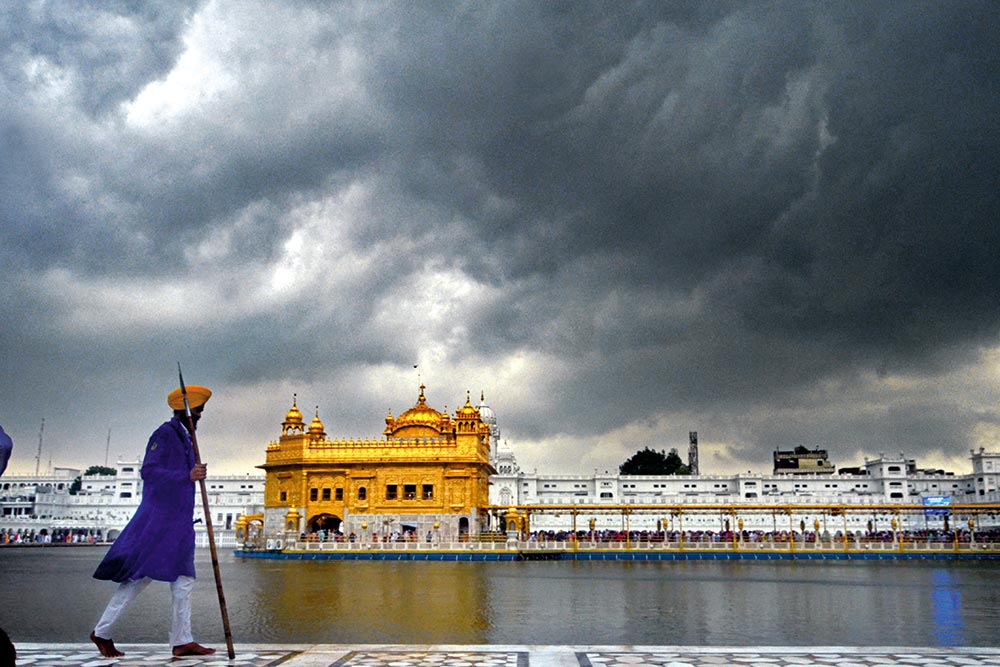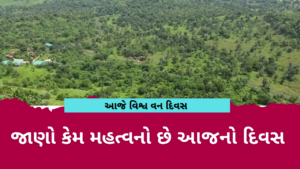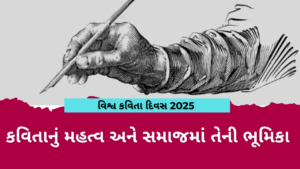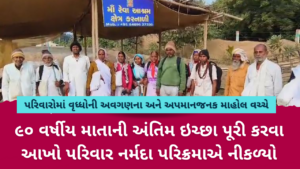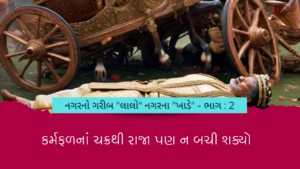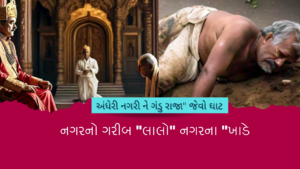Approximately 26- 30 million Sikhs live in the globe today. In the heart of the Sikh religion are gurus. Most of them reside in Punjab. The ninth Guru, Guru Gobind Singh (1666–1708), has established Sikhism and the founder of their faith is Guru Nanak (1469–1539). Religions and their instructors do not live in a vacuum, Mughal monarchs dominated India during the time of the Gurus in the Punjabi society where the Hindus and Muslims coexisted.
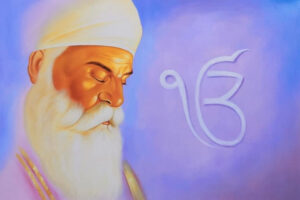 From the teachings of the Gurus and the devotion of their followers, the Sikh religion developed into a global religion with its own scripture, code of conduct, gurdwaras, festivals, and life cycle rites. Sikhs celebrate their unique history and share a strong sense of identity.
From the teachings of the Gurus and the devotion of their followers, the Sikh religion developed into a global religion with its own scripture, code of conduct, gurdwaras, festivals, and life cycle rites. Sikhs celebrate their unique history and share a strong sense of identity.
One of the main tenets of the Gurus’ teachings is the significance of reconciling spirituality with fulfilling one’s obligations. Sikhs should do simaran (remembering God) in addition to seva (voluntary service to others). Being sant sipahi (warrior saint) is the ideal; this person possesses both spiritual attributes and the bravery to act courageously. The first Guru, Guru Nanak, and the tenth Guru, Guru Gobind Singh, are still central to Sikh religious experiences.
Who was Guru Nanak?
Early days
In the Punjab province of now Pakistan, at a location known as Nankana Sahib, Talvandi was the birthplace of Guru Nanak in 1469. His parents were Hindus with a familial history of accounting for the money because they belonged to the Khatri caste. Similar to his sister ‘Nanaki’, the name ‘Nanak’ might suggest that they were born at their mother’s parents’ house, referred to as their ‘nanake’ in Punjabi. Sulakhani, the wife of Guru Nanak, gave birth to two boys. Prior to a profoundly transformative religious encounter, Nanak worked as a governor for Babur’s regime.
Turning point
He used to bath in the river every day when at the age of thirty, he got carried away into God’s presence. As a result, he started his life’s mission of sharing his spiritual insights and gave up his belongings. He accomplished this by writing poetry pieces that he sung to the tune of Mardana, his Muslim travelling companion, playing the ‘rabab’, a stringed instrument. Following his lengthy travels, Guru Nanak made his home at Kartarpur, also known as ‘Creator Town,’ where he gathered a Sikh community around him.
Understanding
The shabads (poetry) of Guru Nanak found in the Guru Granth Sahib proves his understanding about the world’s many occurrences which are all part of one ultimate truth or ik onkar. In contrast to overtly religious behaviour, his shabads highlight the value of integrity as well as the significance of remembering naam (God’s name) and daan. His poetry are full of vivid descriptions of birds, animals, and human endeavours like farming and trade.
Becoming ‘Baba’
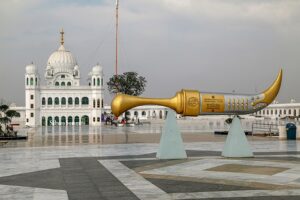 In addition to his inspirational teachings, Guru Nanak is significant because he laid the groundwork for a new religious movement by finding a community of his followers at Kartarpur and selecting his successor, Guru Angad, based on his loyal devotion. Punjabi Muslims, Sikhs, and Punjabi Hindus all revere Guru Nanak as ‘Baba Nanak.’
In addition to his inspirational teachings, Guru Nanak is significant because he laid the groundwork for a new religious movement by finding a community of his followers at Kartarpur and selecting his successor, Guru Angad, based on his loyal devotion. Punjabi Muslims, Sikhs, and Punjabi Hindus all revere Guru Nanak as ‘Baba Nanak.’
Sikhs commemorate his birthday on the full moon day in November each year. Similar to other gurpurabs, which are celebrations honouring a Guru, this one is distinguished by an akhand path, which is a 48-hour uninterrupted reading of the Guru Granth Sahib that concludes on the morning of the festival.
Gurus in Sikhism
The term ‘Guru’ signifies instructor, same as the word ‘Sikh’ means learner. ‘Guru’ is defined by Sikhs as the ‘remover of darkness.’ There are total eleven Gurus. Their lives spanned between Nanak’s birth in 1469 and Guru Gobind Singh’s death in 1708. The Guru Granth Sahib is considerably more than just a book; in addition to having writings by six of the ten Gurus, it is said to represent the Guru himself. God, whose several titles include ‘Satguru’ (the genuine Guru) and ‘Waheguru’ (a term that originated as an expression of acclaim), is the supreme Guru (Nanak’s Guru).
Nanak’s successors
Sikhs hold that the ten human Gurus all represented the same spirit of ‘Guruship’, and that the variations in their styles were suitable for the various contexts in which they were lived. Poets also were Guru Angad Dev, Guru Amar Das, Guru Ram Das, and Guru Arjan Dev, the first four successors to Guru Nanak. Their writings served as the foundation for the Guru Granth Sahib, together with those of Guru Nanak. Even while they carried on Guru Nanak’s spiritual focus in a seamless manner, each added something unique to Sikh communal life. The scripture is written in the Gurmukhi character, which was established by Guru Angad. It most likely originated as a simplified form of the script still in use for the earlier Sanskrit language, which was derived from the shorthand used by accountants to manage their accounts.
Other achievements
A communal vegetarian lunch that is consumed by individuals of all socioeconomic classes while seated together, the langar was established by Guru Amar Das and is now a fundamental aspect of Sikh life. Among his other achievements were the establishment of a Sikh pilgrimage site and the appointment of preachers to guide Sikh congregations in the area. His son-in-law and heir, Guru Ram Das, established the town that would eventually be called Amritsar and assigned stewards-cum-missionaries to oversee worship and gather contributions. Its name, which means ‘the pool of immortality,’ alludes to the pool near the Harmandir Sahib shrine, which was finished during the reign of Guru Arjan Dev, the fifth Guru. Guru Arjan Dev erected the scripture collection, which included poetry by other spiritual poets including Kabir and the first five Gurus, at Harmandir Sahib in 1604.
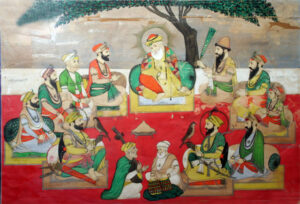 Another fact about Guru Arjan Dev is that he was the first Sikh martyr. Har Gobind, the son of the sixth Guru, rose to prominence in the military after his father’s passing. In the same way, Guru Gobind Rai, the tenth Guru, adopted a prominent military persona. His father, Guru Tegh Bahadar, is likewise revered as a martyr. Guru Tegh Bahadar, Har Rai, and Har Krishan—were not military commanders; in fact, Guru Har Krishan died when still a small kid. The brahmins of Kashmir who had appealed to Guru Tegh Bahadar for assistance were supported. He was executed because he refused to convert to Islam.
Another fact about Guru Arjan Dev is that he was the first Sikh martyr. Har Gobind, the son of the sixth Guru, rose to prominence in the military after his father’s passing. In the same way, Guru Gobind Rai, the tenth Guru, adopted a prominent military persona. His father, Guru Tegh Bahadar, is likewise revered as a martyr. Guru Tegh Bahadar, Har Rai, and Har Krishan—were not military commanders; in fact, Guru Har Krishan died when still a small kid. The brahmins of Kashmir who had appealed to Guru Tegh Bahadar for assistance were supported. He was executed because he refused to convert to Islam.
Tradition has it that in 1699, after gathering his disciples and initiation of five men who offered their life for him, Guru Gobind Rai became Guru Gobind Singh. The Khalsa, the community that owes its devotion to the Guru, is made up of these five (also known as the ‘five beloved ones,’ or panj piare) and all other Sikhs who were initiated in a similar manner over the years. After receiving the amrit, or holy water of initiation, from the panj piare, Guru Gobind Singh adopted the name Singh, meaning ‘lion,’ in lieu of his previous name.
Amritdhari Sikhs, also referred to as Khalsa initiates, embrace a daily discipline that includes bearing five distinguishing marks, or the “five Ks”: kesh (hair, meaning one should not cut or remove hair or beard), kirpan (sword), kachha (shorts, which are typically worn under one’s outer clothing these days), kangha (comb), and kara (iron or steel bangle). Initiates who are female are given the name ‘Kaur,’ which means ‘princess.’ The names Singh and Kaur are not indicative of initials; in fact, many Sikh parents give these names to their children.

